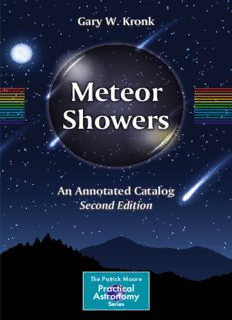Table Of ContentGary W. Kronk
Meteor
Showers
An Annotated Catalog
Second Edition
The Patrick Moore
The Patrick Moore Practical Astronomy Series
For further volumes:
http://www.springer.com/series/3192
Meteor
Showers
An Annotated Catalog
Gary W. Kronk
Second Edition
Gary W. Kronk
Hillsboro , MO , USA
ISSN 1431-9756
ISBN 978-1-4614-7896-6 ISBN 978-1-4614-7897-3 (eBook)
DOI 10.1007/978-1-4614-7897-3
Springer New York Heidelberg Dordrecht London
Library of Congress Control Number: 2013948919
© Springer Science+Business Media New York 1988, 2014
This work is subject to copyright. All rights are reserved by the Publisher, whether the whole or part of
the material is concerned, speci fi cally the rights of translation, reprinting, reuse of illustrations, recitation,
broadcasting, reproduction on micro fi lms or in any other physical way, and transmission or information
storage and retrieval, electronic adaptation, computer software, or by similar or dissimilar methodology
now known or hereafter developed. Exempted from this legal reservation are brief excerpts in connection
with reviews or scholarly analysis or material supplied speci fi cally for the purpose of being entered and
executed on a computer system, for exclusive use by the purchaser of the work. Duplication of this
publication or parts thereof is permitted only under the provisions of the Copyright Law of the Publisher’s
location, in its current version, and permission for use must always be obtained from Springer. Permissions
for use may be obtained through RightsLink at the Copyright Clearance Center. Violations are liable to
prosecution under the respective Copyright Law.
The use of general descriptive names, registered names, trademarks, service marks, etc. in this publication
does not imply, even in the absence of a speci fi c statement, that such names are exempt from the relevant
protective laws and regulations and therefore free for general use.
While the advice and information in this book are believed to be true and accurate at the date of
publication, neither the authors nor the editors nor the publisher can accept any legal responsibility for
any errors or omissions that may be made. The publisher makes no warranty, express or implied, with
respect to the material contained herein.
Printed on acid-free paper
Springer is part of Springer Science+Business Media (www.springer.com)
This book is dedicated to my wife and best friend,
Kathy.
About the Author
Gary W. Kronk received his Bachelor of Science in Journalism from Southern
Illinois University in Edwardsville. He is employed at Laclede Gas in St. Louis,
where he is a Senior User Support Specialist and occasionally teaches classes on
software programs.
Observing, researching, and writing about comets has been an activity the author
has participated in for most of his life, with over 3,000 observations of over 210
comets. He is the author of seven books and has published in S ky & T elescope ,
Astronomy , I carus , The Journal of the Association of Lunar and Planetary
Observers , and more. His books include C omets: A Descriptive Catalog (Enslow
Publishers, 1984), M eteor Showers (Enslow, 1988), and a six-volume series titled
“Cometography” with Cambridge University Press, whose fi fth volume was pub-
lished in 2010. In 2004, the International Astronomical Union’s Minor Planet
Center announced that minor planet number 48300 was being given the name
“Kronk” in honor of the author’s extensive research for his Cometography series.
vii
Preface
This book contains both historical and current data on what the author believes to
be the most active meteor showers in the sky. Data from the majority of the visual,
photographic, video, and radar studies have been utilized.
The author began his research in the late 1970s with in-depth investigations into
the observations of several major meteor showers, such as the Perseids, Geminids,
Orionids, and Eta Aquarids. This ultimately took the author in a new direction that
led to the creation of a preliminary list of over 600 potential meteor showers. Using
photographic and radar data, the author determined the orbit of each potential
meteor stream. When such data was not available, the author calculated parabolic
orbits for the streams.
The next stage was to establish the probable daily movement of each meteor
stream’s radiant across the sky (also known as the radiant ephemeris). Dozens of
radiant lists published during the nineteenth and twentieth centuries, as well as lists
of photographic and radar meteor orbits were then compared to each preliminary
radiant ephemeris of each potential meteor shower.
Finally, the “D-criterion” was applied to the potential matches, which ultimately
determined the history of each stream, the actual duration, the actual radiant
ephemeris, and the orbit.
This analysis fi rst began on a CDC Cyber 90 mainframe at Southern Illinois
University in Edwardsville (Illinois, USA) in 1980. Work continued on an Atari
800 home computer (48 K RAM) in 1982 and a Macintosh (512 K and 1 M RAM)
from 1985 to 1987. To update the fi rst edition of this book, some of this same analy-
sis was repeated during the last 2 years using an Apple iMac computer with an
8 GB RAM running both Apple OS X and Microsoft Windows 7.
ix
Description:Meteor showers are among the most spectacular celestial events that may be observed by the naked eye, and have been the object of fascination throughout human history. In “Meteor Showers: An Annotated Catalog,” the interested observer can access detailed research on over 100 annual and periodic

